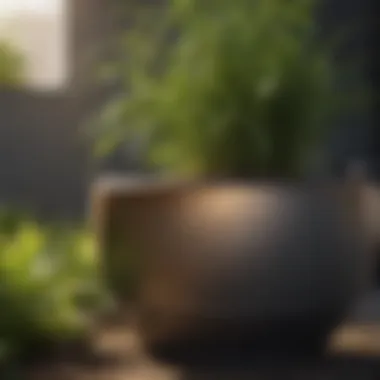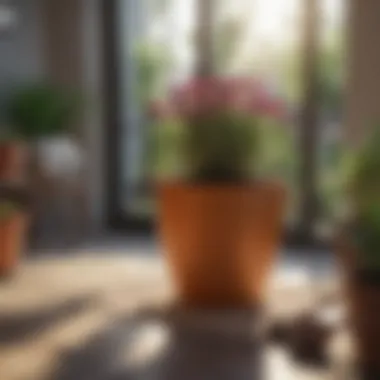Understanding Smart Pots: Innovations in Container Gardening


Intro
In the evolving world of gardening, the introduction of innovative technologies is reshaping how we cultivate plants. Among these advancements, smart pots stand out for their unique properties and benefits. Smart pots refer to fabric containers designed to promote healthy plant growth through enhanced aeration, drainage, and root health. As gardening enthusiasts and professional farmers increasingly seek effective methods to improve plant yield and health, understanding these tools has never been more crucial.
This article will explore key concepts around smart pots, their scientific background, and their use in both home and commercial gardening settings. We will also look into current trends that are driving their popularity and how they fit into sustainable gardening practices.
Furthemore, this guide aims to equip readers with practical knowledge on using smart pots effectively, enhancing their gardening experience, and addressing common challenges that may arise.
Preamble to Smart Pots
The introduction of smart pots in gardening represents a noteworthy shift in how plants can be cultivated in confined spaces. Understanding this concept is crucial for both amateur and professional gardeners. Smart pots provide benefits that enhance plant growth and overall gardening success. They serve not just as containers, but as innovative tools for better plant health and sustainability.
Definition and Overview
Smart pots are modern gardening containers designed for optimal aeration and enhancing root development. Unlike traditional pots, which often restrict root growth, smart pots allow roots to breathe, preventing them from becoming root-bound. Made from breathable fabric, these containers promote healthier plant growth by facilitating better drainage and reducing watering frequency. Smart pots come in various shapes and sizes, catering to different types of plants and gardening techniques, from small herb gardens to larger vegetable plots.
Historical Context
The concept of container gardening is not new; it has roots in ancient agriculture. However, the emergence of smart pots is a recent development, stemming from advancements in horticultural science. Initially, containers were made from materials like clay or plastic. While effective to an extent, these traditional materials often lead to poor drainage and restrict root growth. The invention of fabric pots around the late 20th century introduced a new paradigm. Gardeners and agricultural innovators recognized the potential of using breathable, lightweight materials. As a result, smart pots gradually gained popularity, especially among urban gardeners seeking efficient solutions in limited spaces. Their increasing recognition in professional horticulture also highlights the growing awareness of sustainable gardening practices.
"Smart pots not only represent a technological advancement in gardening; they embody a new approach to how we cultivate plants, emphasizing efficiency and sustainability."
By understanding smart pots, gardeners can make informed choices about their gardening practices. This section lays the foundation for exploring the design, functionality, and various applications of these innovative gardening tools.
Design and Materials
Design and materials are critical components of smart pots, serving as the foundation for their innovations and effectiveness in container gardening. A well-thought-out design allows for optimal plant growth, while the choice of materials significantly influences durability and environmental impact. The focus on these aspects can lead to improved plant health and greater gardening efficiency.
Structural Features of Smart Pots
Smart pots incorporate unique structural features that enhance their usability. One significant aspect is the breathable fabric that allows for air pruning of roots. This method helps in preventing root circling, a common issue in traditional pots. Roots growing towards the pot walls encounter air, causing them to stop growing. Instead of continuing to grow in circles, they branch out, promoting a healthier root system.
The design also provides better drainage and aeration. Smart pots typically have a porous structure that allows excess water to escape easily. This is crucial because it reduces the risk of overwatering, a common pitfall in container gardening. Also, the lightweight nature of these pots makes them easier to handle, which is a substantial advantage for gardeners who move their pots frequently.
Material Composition
The composition of smart pots is mainly focused on ensuring durability and sustainability. These pots are often made from non-woven textiles, which provide excellent drainage and facilitate air circulation. Materials used can range from recycled plastics to biodegradable options, appealing to environmentally conscious gardeners. The ability to choose materials not only affects the performance of these pots but also impacts their longevity. More durable materials can withstand various weather conditions, thereby minimizing the need for replacements.
The difference in material properties among various brands of smart pots can significantly influence gardening outcomes. For example, Fabric Pots made from polypropylene offer flexibility, while Eco-Friendly Pots crafted from biodegradable substances reduce environmental impact. Selecting the right pot depends on individual gardening goals and environmental concerns.
Comparison with Traditional Pots
The juxtaposition of smart pots against traditional clay or plastic containers reveals several benefits. Traditional pots often lack the aeration and drainage capabilities that smart pots deliver. These containers usually restrict root development, resulting in plants that can become root-bound if not monitored closely. In contrast, smart pots actively support root health and growth, leading to more vigorous plant development.
Additionally, traditional pots may retain too much moisture, leading to root rot, while smart pots promote moisture balance through their advanced design. They allow gardeners to better control their watering practices. In terms of usability, smart pots can be easily stored away when not in use due to their flexible nature, while traditional pots take up more space and are bulkier.
"Choosing the right pot is crucial for effective gardening, as it can impact everything from root health to overall plant vigor."
Functionality and Benefits


The functionality and benefits of smart pots are central themes in understanding their value in gardening. Smart pots bring numerous advantages over traditional methods. These range from enhanced aeration to improved water retention and efficient nutrient utilization. With these pots, gardeners can enjoy healthier plants and more productive yields. The integration of innovation in design and materials effectively transforms conventional gardening practices.
Aeration and Drainage Mechanisms
Smart pots are engineered to facilitate optimal aeration. This design feature enhances the exchange of gases between soil and surrounding atmosphere. Air circulation around the root zone is crucial as it helps prevent root rot and promotes vigorous root growth. The drainage mechanisms also play a significant role. They enable excess water to escape easily, preventing waterlogging that can hinder plant growth. The porous nature of smart pots allows for rapid evaporation, which assists in maintaining an ideal moisture level within the soil. This function is particularly beneficial in wet conditions, where traditional pots might retain too much moisture.
"The unique structure of smart pots aids in maintaining a healthy balance of moisture and oxygen, which is critical for plant vitality."
Root Development Benefits
The benefits of root development in smart pots cannot be overlooked. Traditional pots often restrict root growth due to limited space and poor drainage. In contrast, smart pots encourage root development by providing an environment that supports lateral growth. Roots can easily penetrate the sides of the pot, where they encounter air, which encourages root pruning. This process enhances the root system, leading to more robust plants. A well-developed root system is paramount for nutrient absorption and overall plant health, contributing to higher resilience against stressors.
Water Management Efficiency
Water management is another crucial aspect of smart pots. These pots reduce water usage significantly when compared to traditional containers. The air-pruning action helps regulate the moisture level, ensuring that plants receive the right amount of water without waste. Smart pots also promote capillary action, assisting in the uptake of water from the soil. This efficiency leads not only to thriving plants but also supports sustainable gardening practices, catering to an audience concerned with environmental responsibility. By minimizing water usage, smart pots contribute to a more sustainable gardening approach, making them valuable for both amateur and professional horticulturists alike.
Applications in Gardening
The significance of smart pots in gardening cannot be understated. With their innovative design and functionality, these containers have revolutionized the way plants are cultivated in both domestic and professional settings. As container gardening continues to grow in popularity, understanding various applications for smart pots becomes essential for enthusiasts and farmers alike. This section explores specific methodologies, benefits, and considerations regarding the use of smart pots in gardening.
Container Gardening Techniques
Container gardening is an efficient way to grow plants in limited spaces. Smart pots enhance this technique by offering superior aeration and drainage. The air pruning feature of smart pots encourages healthier root systems, leading to more vigorous plant growth. When employing container gardening techniques, the flexibility of smart pots allows gardeners to adjust plant positioning based on sunlight, water needs, or aesthetic preference.
Smart pots are available in various sizes and shapes, allowing for tailored solutions based on specific plant types. When gardening in urban environments or places with poor soil, these pots provide an ideal alternative. One of the main advantages is their lightweight nature, making them easy to move around as needed.
Key techniques to consider include:
- Layering soil mixes that suit the plant’s needs
- Using drip irrigation systems for efficient watering
- Grouping pots together to create a microclimate for plants
These strategies maximize the functionality of smart pots, leading to a productive gardening experience.
Vegetable and Herb Cultivation
The cultivation of vegetables and herbs in smart pots presents numerous benefits. The temperature control and moisture retention properties of these containers promote a conducive growing environment. Vegetables such as tomatoes, peppers, and herbs like basil and cilantro thrive in the well-aerated conditions provided by smart pots.
Moreover, the portability of smart pots allows for seasonal rotation or changes in the garden layout. This can significantly enhance a gardener's yield. Regularly switching locations can also reduce the risk of disease buildup in one area.
Considerations for successful vegetable and herb cultivation include:
- Choosing the appropriate pot size based on plant growth potential
- Implementing companion planting to maximize space and deter pests
- Ensuring proper fertilization methods for robust growth
By adhering to these practices, gardeners can effectively use smart pots to cultivate a bountiful harvest.
Landscape and Decorative Use
Smart pots have aesthetic and functional advantages in landscaping. They offer diverse design possibilities, allowing for creative arrangements in gardens, patios, or balconies. With a variety of sizes and colors, smart pots can enhance the overall visual appeal of outdoor spaces.
In landscaping, smart pots can also play a role in urban greening projects. They provide an excellent option for planting trees in areas with restricted soil access. Their design helps retain moisture and promote healthier growth in otherwise inhospitable environments.
Advantages for landscape and decorative use include:


- Enhanced air circulation leading to robust plant establishment
- Ability to create vertical gardens or living walls with multiple pots
- Mobility for seasonal color changes or event setups
Impact on Plant Health
The influence of smart pots on plant health cannot be understated. The design and technology behind smart pots significantly improve the growth conditions for various plants. Healthy plants are not just a result of good soil or sufficient water; they also depend on the container they grow in. Smart pots provide unique advantages that directly promote vitality and resilience in plants.
Nutrient Availability and Soil Health
Smart pots also enhance nutrient availability within the soil. The structure of these containers encourages healthy microbial activity. This is important because beneficial microbes help break down organic matter, releasing essential nutrients for plant uptake. Furthermore, smart pots facilitate better drainage, preventing nutrient leaching that can occur in conventional pots. This means that nutrients remain available to the plants for longer periods. Improved aeration due to the design allows for proper root development and efficient nutrient absorption. The interaction between soil health and plant performance is crucial for sustained growth and productivity.
Disease Resistance and Management
Another noteworthy aspect is the role of smart pots in promoting disease resistance. The breathable materials used in their construction prevent excess moisture build-up, which is a key factor in many plant diseases. By reducing humidity around the root zone, smart pots create an unfavorable environment for pathogens. Additionally, many gardeners notice fewer root diseases when using these pots, as the enhanced aeration supports robust root systems. As plants become healthier, their natural resilience to diseases increases. Thus, adopting smart pots can form a part of an effective disease management strategy in gardening.
Pest Control Strategies Using Smart Pots
Pest management is also improved through the use of smart pots. The physical characteristics of smart pots can create barriers that deter some pests. Moreover, the improved drainage and airflow reduce standing water, which is often a breeding ground for insects. Gardeners can combine smart pots with companion planting and organic pest control methods to develop an holistic strategy. For instance, pairing certain plants can create a more balanced ecosystem, reducing the chances of infestations. Implementing these strategies can lead to healthier growth and better yields in the long run.
"The benefits of smart pots extend beyond just aesthetics; they touch every aspect of plant health."
Sustainability Considerations
Sustainability plays an essential role in modern gardening practices, particularly with the rise of container gardening. This section examines how smart pots contribute to sustainable gardening, discussing various critical aspects like environmental impact, water usage, and overall product lifecycle. Transitioning to smart pots can be pivotal not just for individual gardens, but for broader ecological benefits as well.
Environmental Impact of Smart Pot Materials
The materials used in smart pots are crucial in evaluating their sustainability. Unlike conventional plastic pots, many smart pots are made from breathable, durable fabrics such as non-woven polypropylene. This material allows for air pruning of roots and promotes healthier plant growth. Moreover, by utilizing recyclable materials, the overall environmental footprint of smart pots decreases.
The impact of manufacturing these pots also requires attention. If the production involves toxic chemicals or processes that harm the environment, the sustainability claims may be weakened. It is vital to choose brands that disclose their production methods and material sources. Consumers are increasingly aware of how their gardening products affect the planet, leading companies to prioritize environmentally sound practices.
Water Conservation Practices
One significant benefit of smart pots is their role in effective water management. Due to the superior drainage and aeration, these pots often require less frequent watering compared to traditional pots. This water efficiency is not only beneficial for the plants but also conserves a precious resource in a world facing water scarcity.
Using smart pots can help gardeners develop better habits for water conservation. Techniques such as allowing the soil to dry slightly between waterings can enhance root health and encourage deeper root growth while saving water. This approach promotes a sustainable gardening practice that decreases water waste and improves soil health over time.
Lifecycle Assessment of Smart Pots
Evaluating the lifecycle of smart pots offers insights into their environmental sustainability. Lifecycle assessment involves examining the impact of a product from raw material extraction through its use and eventual disposal. Smart pots are generally lightweight, which can reduce transportation emissions compared to traditional clay or ceramic pots.
Consideration should also be given to how long the pots last. Many smart pots are designed for longevity; they resist degradation from UV exposure and are less prone to cracking. When they eventually reach the end of their functionality, choosing recyclable options can further mitigate environmental impact. This holistic view of a product's lifecycle aids in making informed and responsible choices, especially for environmentally conscious gardeners.
"Sustainability is not just a trend; it is becoming a vital component of responsible gardening practices."
In summary, assessing sustainability considerations in gardening practices means looking closely at materials, water usage, and the entire lifecycle of products like smart pots. Making informed choices can contribute positively to the environment while also promoting robust plant growth.
Common Missteps and Challenges
Container gardening with smart pots offers numerous advantages. However, it is not without its challenges. Addressing these missteps is crucial for achieving optimal plant health and growth. Recognizing the common pitfalls can ensure a more productive experience. Here, we will examine some significant challenges that gardeners often face when using smart pots.


Overwatering and Its Consequences
Overwatering is one of the most frequent mistakes among gardeners using smart pots. Given the enhanced drainage properties smart pots provide, they can make it tempting to assume that more water is better. However, just because the pots drain effectively does not mean that plants need excessive amounts of water.
When plants sit in waterlogged soil, their roots can suffocate. This leads to root rot, which can be fatal to the plant. Symptoms of overwatering include yellowing leaves, wilting, and a general lack of growth. To avoid this, it is important to regularly check the moisture level of the soil. Stick your finger an inch into the soil; if it feels damp, wait before watering again. Understanding your plant's specific water needs is vital.
Insufficient Light Conditions
Another challenge is inadequate lighting. Smart pots do not influence light availability, and whether a plant thrives significantly depends on the amount of light it receives. Gardeners often underestimate how much sunlight their plants need.
For example, some plants prefer full sun while others thrive in partial shade. Inspect where smart pots are placed. If they are under awnings or shaded by larger plants, they may not be getting enough light. As a solution, one should assess light levels before planting, and consider moving the pots if natural light seems insufficient. Monitor the growth closely to gauge if plants show signs of stress due to low light.
Fertilization Errors with Smart Pots
Fertilization is another area where missteps can occur. Smart pots allow for superior aeration and drainage, but this can also lead to nutrients leaching out more rapidly. Therefore, a common issue is insufficient nutrient availability. Many beginners underestimate how often they need to fertilize when using these pots.
Gardeners should use a slow-release fertilizer specifically designed for container plants. It is also important to consider the plant type since nutrient requirements can vary greatly. Regular assessment of the soil and plant health will help in adjusting fertilization methods appropriately. Monitoring the feeding habits continuously will optimize nutrient uptake, ultimately improving plant vigor.
"Understanding and addressing common gardening mistakes can vastly improve outcomes in container gardening with smart pots."
Care and Maintenance
Effective care and maintenance are critical components in ensuring the longevity and performance of smart pots. A well-maintained smart pot not only extends its lifespan but also optimizes the growing conditions for plants. Understanding this segment allows gardeners to enhance both their garden aesthetics and productivity through the right practices.
Cleaning Procedures for Longevity
Keeping smart pots clean is essential for preventing diseases and promoting healthy growth. Regular cleaning can remove accumulated salts, residues, or pathogens that may affect plant health. The cleaning process generally involves the following steps:
- Rinse: Begin by rinsing the smart pot with water. This helps dislodge surface residues and particles.
- Scrub: Use a soft brush or cloth with a mild soap solution to scrub the interior and exterior surfaces. Avoid harsh chemicals that may harm the material or degrade it over time.
- Rinse Again: Thoroughly rinse the pot with clean water to remove any soap residue. This helps to ensure that plants will not be exposed to harmful substances when re-planted.
Regular cleaning may reduce the risk of root rot and foster an environment conducive to growth.
Seasonal Preparations and Storage
Seasonal care is important for maintaining smart pots efficiently. As seasons change, so do the requirements for care and storage. Here are some recommended practices:
- Before Winter: Clean the pots thoroughly and store them in a dry, sheltered place to prevent damage from extreme cold. If pots are left outdoors, they may crack or warp.
- Preparing for Spring: Inspect the pots for any signs of wear. Repair or replace any damaged pots before the planting season begins. This preparation ensures optimal growing conditions when it is time to plant.
- During Summer: Regularly check for dirt and algae buildup. Clean as necessary to maintain optimal conditions for plant health.
By paying attention to these practices in care and maintenance, gardeners can ensure their smart pots remain effective and support healthy plant growth throughout the seasons.
Epilogue
The importance of the conclusion in this article lies in synthesizing all aspects of smart pots revealed in prior sections. Here, we summarize the critical insights gathered from the analysis of their design, materials, and functionalities. This article serves to elucidate how smart pots enhance container gardening and offer sustainable practices. Additionally, it highlights the ongoing advancements in this gardening technology that are beneficial for both experienced horticulturists and novices alike.
Summary of Key Insights
Smart pots are innovative tools that revolutionize container gardening. Key insights from this article include:
- Aeration and Drainage: Smart pots facilitate superior aeration and drainage compared to traditional pots. This leads to healthier root systems.
- Material Benefits: The composition of smart pots, typically non-woven fabric, encourages air pruning of roots, thereby promoting robust plant growth.
- Water Efficiency: Smart pots allow for better water management, reducing the risks of overwatering while improving moisture retention.
- Applications: These pots can be utilized in diverse settings, from urban balcony gardens to expansive agricultural landscapes, emphasizing their versatility.
- Sustainability: The design of smart pots aligns with sustainable practices, promoting water conservation and optimal nutrient use.
Overall, smart pots present numerous advantages that enhance gardening practices while supporting plant health and environmental sustainability.
Future Directions in Smart Pot Technology
As technology continues to evolve, the future of smart pots holds exciting potential. Factors influencing this evolution include:
- Improved Materials: Innovations in material science may lead to new, more sustainable, and durable fabrics that enhance the longevity and functionality of smart pots.
- Integration of Smart Tech: The incorporation of sensors and smart technology can provide real-time data on soil moisture, nutrient levels, and plant health, allowing for precise care.
- Customization: Future designs may allow for greater customization based on specific plant needs or climatic conditions.
- Wider Adoption: As awareness of environmental issues increases, more farmers and gardening enthusiasts may opt for smart pots, reinforcing sustainable gardening practices.







